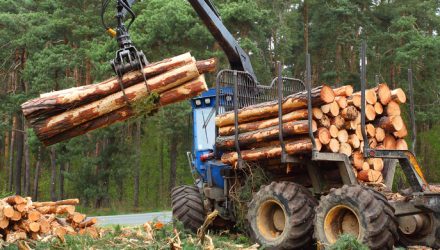The timber industry and sector-related ETFs experienced a wild ride this year as weather conditions and a booming housing segment fueled wide swings in the industry.
The iShares Global Timber & Forestry ETF (NYSEArca: WOOD) increased 19.6% and Invesco MSCI Global Timber ETF (CUT) advanced 22.9% in 2019.
Timber producer stocks experienced wide oscillations through the year after lumber prices plunged as much as 15% to this year’s low of $286.1 per 1,00 board feet in late May Bloomberg reports.
The unusually wet spring season pressured home builders and caused U.S. housing starts to slow early in the year while producers in Canada’s British Columbia were struggling to maintain supplies.
However, conditions turned to for the better when lumber producers cut production and U.S. housing starts recovered, with lumber prices now to lock in an annual gain of 27%.
U.S. homebuilding jumped more-than-expected in November and permits for future home construction rose to a twelve-and-a-half year high due to lower mortgage rates.
Looking ahead, the lumber industry could continue its rally into 2020. Kevin Mason, managing director of ERA Forest Products Research, argued that Canadian curbs will keep supplies tight in North America.
“It’s going to be definitely a much stronger market,” Mason told Bloomberg.
The iShares Global Timber & Forestry ETF provides exposure to global equities related to the timber and forestry industry, including companies that produce forest products, agricultural products, and paper and packaging products, along with real estate that manages these lands. For example, its top holdings include Rayonier REIT, Svenska Cellulosa, Weyerhaeuser REIT, Potlatchdeltic Corp and West Fraser Timber.
The Invesco MSCI Global Timber ETF also includes exposure to securities engaged in the ownership and management of forests, timberlands and production of products using timber as raw materials. Top holdings include Mondi, Amcor, Westrock, UPM-Kymmene Oyj and Weyerhaeuser.
WOOD provides greater global diversification but it is also slightly more top heavy in its allocations. On the other hand, CUT includes greater exposure to the U.S. markets.
For more information on the markets, visit our current affairs category.

